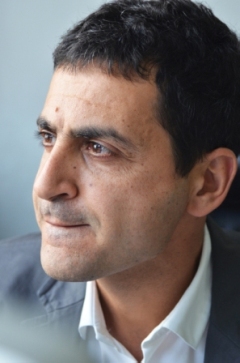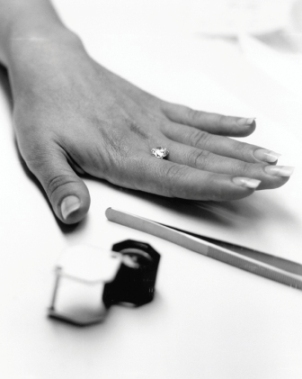High-End Investments
August 22, 12
Be they pink, blue, orange or just very large white stones, high-end diamonds are very rare, very special and very sought after, making them a great investment.
Investment in these types of items is made mainly by connoisseurs, high net worth individuals who either understand what they are buying, or have someone trustworthy to advise them.
While the most visible are purchases made at Christie's or Sotheby's, these transactions represent only a fraction of total business.
"This is the best possible investment," says Eden Rachminov of Rachminov Diamond 1891, a fancy color diamond trader who authored the Fancy Color Diamond Book. He is citing a diminishing supply as the key reason for investing.
 Oded Mansori |
Oded Mansori of R.D.H. Diamonds, who advises, manufactures and trades in high-end diamonds, says that even with a steady supply, the number of rough stones mined and offered on the market is very limited. "Only two or three rough stones that result in +10 carat D/IF stones enter the market in any given month," he says, adding that there is hardly any price decline in these goods because they are usually in "strong hands," which means traders who can afford to hold on to an expensive stone for a while and not sell for a lower price.
This trait characterizes high-end diamond investments. "Even in the secondary market, goods return to the market rarely. Usually they remain in the hands of the family," says Mansori. "High-end diamonds return to the market less often then say diamonds of about 3 carats, which are sometimes sold to pay a debt or a mortgage."
He estimates that while about 4 percent of 3 carat diamonds return to the market from private hands, less than 1 percent of high-end diamonds find their way back owing to the enduring financial wealth of those who buy high-end diamonds.
"More and more money from outside the diamond industry is seeking high-end stones, and always prefers buying the highest quality available."
According to Mansori, in 2008, when commodities fell 30 percent or more, the only items that did not lose value, and in some cases even appreciated, were +10 carat D/IF goods and the expensive fancy color goods – blues, pinks and reds.
Testimony to this view is the record-breaking price paid at a Christie's auction in December 2008. Graff Diamonds paid $24.26 million for the cushion-shaped deep grayish blue VS2 Wittelsbach Diamond, a record price for any diamond or jewel sold at auction.
The "Star of Josephine," a fancy vivid blue, weighing 7.03 carats, sold in May 2009 for $9.49 million, or $1.35 million per carat, making it the most expensive per carat stone ever sold in any category. The diamond was cut from a 39.19-carat blue diamond mined by Petra in South Africa, which sold for $8.8 million at a tender – also during the recession.
Rachminov, while a staunch believer in the investment value of fancy color diamonds, adds some caution when discussing diamond investment firms. "Their buyer needs to be an alley cat and understand the market well," he cites as a pre-requisite for any firm investing in diamonds. "There are some former Sotheby's and Christie's guys trying to do this, but they lack the experience," Rachminov estimates that only about 2-3 percent of high-end goods are sold at the auction houses.
"The firm needs a buyer who is a diamond trader. The profit is in a good purchase," he emphasizes.
Rachminov also points out an issue that still exists in fancy color diamonds – price transparency. Because so few stones are sold through auction houses, investors may not know for how much the buyer actually bought the diamonds. Despite the attractiveness of investing in high-end diamonds, he feels that until now, none of the firms has done it right.
However, the auction houses do play an important role in the high-end diamond arena. Not only do they keep awareness high, they are market makers in terms of price and create a very high benchmark for single color diamonds.
"The main strong players in the market have an interest in maintaining and/or push the prices upward. It is a safety net that makes investing in such diamonds worthwhile," says Mansori.
According to both traders, buying at the auction houses is good for a long-term strategy – according to Rachminov, at least three years. They caution, however, that buying at an auction house "burns" the diamond for a while sice everyone knows how much it was bought for and buyers will not pay much above that price.
 |
In the open market, however, returns can be hefty. Rachminov says they can be "high" while Mansori estimates the appreciation at about 15 percent annually for high-end, well bought, diamonds.
Novel Ways to Price Transparency
One issue that repeatedly comes up in the context of investment in diamonds is price disclosure. Most of the ventures dealing with "bread and butter" goods, are basing price disclosure on third party analysis, for example SDX's reliance on IDEX Online's market driven data. This analysis is based on data generated from large volumes of the relevant goods.
With large and fancy color diamonds, this is not possible. The rarity of these items is so great that differences between goods are significant. In addition, because there are so few items sold each year – with most sales being discreet transactions – a statistical analysis is nearly impossible.
Harry Winston’s DAA fund, will buy these goods, which will then be handed to Harry Winston on memo terms to set in its jewelry. It will then offer the jewelry at its boutiques around the world. Once sold, Harry Winston is paid a fee for the selling service, and the fund receives the rest of the proceeds. This is an elegant solution to the price discovery issue. Investors will know much a diamond is sold, not just the price of diamonds like it.
DAA is currently in the process of raising the first $50 million of a total $250 million. About a quarter of the capital will be put in “Special Allocation” of special stones, 6 carat and larger DEF color, or fancy color diamonds of any size. The expected turnover of these goods is 0.8 times a year, carrying an expected return of 15-30 percent.
The remaining 75 percent of the capital will be invested in the core allocation of 0.5-5.99 carat DEF goods. Here the expectation is that turnover will be about once a year, with an expected 13 percent appreciation.
All goods will be VS+ clarity, non-florescent with at least Very Good make and will need to pass Harry Winston's quality control system to ensure they are suitable for a Harry Winston jewelry item.
One criticism the fund is facing is that, in a way, investors are asked to finance Harry Winston's inventory. With a name for expensive, high-end stones, the kind that typically take one to three years to sell, this is clearly an expensive inventory. Coupled with the company's drive to add more boutiques, the need to enlarge this inventory faster than it sells it is clearly a major burden on the retailer's financing.
Asked about the two "allocations," an insider said the goal in defining the range broadly is to avoid a price bubble. If the company buys $50-$75 million worth of narrowly defined rare diamonds at once, the market will react with price increases, decreasing the margin of appreciation.
The DAA system will have an extra benefit. It will create a large database of prices of special goods. After a while, and once it reaches critical mass, this database could serve as a price benchmark for this range of goods.